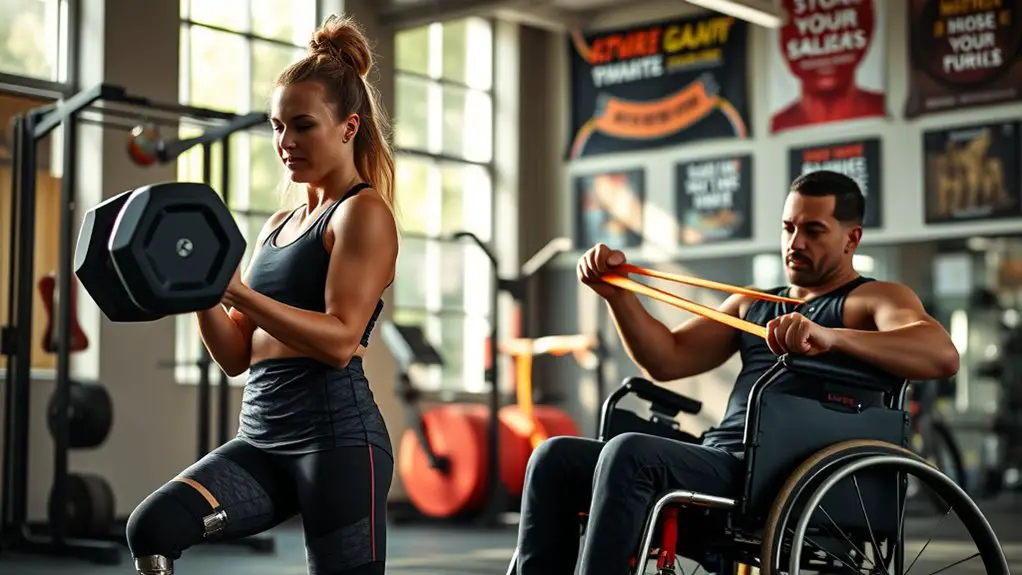To safely increase your draw weight with strength training, focus on building strength in key muscle groups like your back, shoulders, and core. Start by evaluating your current strength level and use exercises such as pull-ups, resistance band rows, and planks to enhance muscle endurance and power. Create a balanced workout routine that includes cardio and flexibility training. Monitor your progress, and be mindful of injury prevention strategies. You'll find more tips to support your journey ahead.
Understanding Draw Weight and Its Importance
Draw weight refers to the amount of force required to pull back a bowstring, and it plays an essential role in your archery performance. Understanding draw weight is important for mastering archery fundamentals and ensuring you hit your target consistently. When you choose a draw weight that matches your strength and skill level, you'll experience greater accuracy and control, giving you the freedom to express yourself through every shot.
If the draw weight is too high, you risk fatigue and poor shooting form, while too low a draw weight can limit your power and distance. Finding the right balance allows you to enjoy the sport fully. As you train and your strength improves, gradually increasing your draw weight can enhance your performance and boost your confidence. Embrace the journey of discovering your ideal draw weight, and let it empower you to reach new heights in your archery pursuits.
Assessing Your Current Strength Level
Before you increase your draw weight, you need to evaluate your current strength capacity. This means identifying the muscle groups that are essential for drawing your bow effectively. By understanding where you stand now, you can set realistic and safe goals for your progression.
Evaluate Existing Strength Capacity
Evaluating your current strength level is essential for safely increasing draw weight. Conducting a thorough strength assessment helps you understand your existing capacity. Start by identifying how much weight you can comfortably draw and hold, ensuring you're not pushing beyond your limits. Use basic exercises to evaluate your endurance and power in related muscle groups; this will give you a clearer picture of your starting point. Make notes on any areas of weakness or imbalance, as these insights are vital for a tailored training plan. Remember, the goal is to build strength progressively without risking injury. By knowing your current capabilities, you can set realistic targets and achieve the freedom you seek in your archery pursuits.
Identify Target Muscle Groups
Understanding which muscle groups are essential for archery can greatly enhance your training efforts. To effectively increase your draw weight, focus on target muscle identification and how to engage them properly. Here are three key muscle groups you should concentrate on:
- Back Muscles: Strengthening your lats and rhomboids improves your draw motion.
- Shoulder Muscles: Engage your deltoids and rotator cuffs for better stability and control.
- Core Muscles: A strong core supports your posture and balance during the draw.
Key Muscle Groups for Archery Performance
When it comes to archery performance, having the right muscle groups engaged is fundamental for achieving ideal draw weight and accuracy. Focus on your back muscles, particularly the latissimus dorsi and rhomboids, as they help stabilize your draw while maintaining a solid archery grip. Your shoulders, especially the deltoids and rotator cuff muscles, are critical for a smooth motion throughout your shooting stance. Don't overlook your core; a strong torso supports balance and control, allowing for better alignment and steadiness.
Additionally, your arms and forearms play an essential role in maintaining your grip and drawing the bow effectively. The biceps and triceps work together to generate power while the forearm muscles guarantee a firm grip during each shot. By strengthening these key muscle groups, you'll enhance your overall archery performance, giving you the freedom to shoot with confidence and precision.
Effective Strength Training Exercises
To boost your draw weight effectively, incorporating targeted strength training exercises into your routine is essential. Here are three exercises that can help you increase your muscle strength and endurance:
- Pull-ups: Great for building upper body strength, they engage your back, shoulders, and arms, vital for archery.
- Resistance Band Rows: These mimic the motion of drawing a bow, helping to enhance your pulling power while also providing flexibility.
- Plank Variations: Strengthening your core stabilizes your posture and generates power from your center, improving your overall shooting form. Additionally, engaging in exercises like squats can further enhance your lower body strength, contributing to better stability and balance during archery.
Creating a Balanced Workout Routine
Incorporating strength training exercises like pull-ups, resistance band rows, and plank variations is just one part of the equation for increasing your draw weight. To truly maximize your progress, you need a balanced workout routine that includes cardio and flexibility training, too.
Here's a simple structure to reflect upon:
| Day | Activity |
|---|---|
| Monday | Strength Training |
| Tuesday | Cardio (Running/Cycling) |
| Wednesday | Flexibility (Yoga) |
| Thursday | Strength Training |
| Friday | Active Recovery |
Finding the right workout frequency is essential; aim for at least three strength sessions per week while ensuring you're fueling your body with balanced nutrition. This holistic approach not only helps you safely increase your draw weight but also keeps you energized and motivated. Additionally, incorporating functional strength training can enhance your overall athletic performance and support your journey. Embrace the journey and enjoy the freedom that comes with a balanced routine!
Incorporating Resistance Training
Incorporating resistance training is key to boosting your draw weight effectively. You'll want to focus on targeted muscle groups, use progressive overload techniques, and maintain proper form to avoid injury. Let's explore how each of these elements can enhance your strength and stability. Additionally, developing your core strength can reduce injury risk and improve your overall stability during strength training exercises.
Targeted Muscle Groups
Targeting specific muscle groups is essential for safely increasing draw weight. By focusing on targeted exercises, you can enhance muscle activation in key areas that directly impact your archery performance. Consider incorporating the following muscle groups into your routine:
- Back Muscles: Strengthen your latissimus dorsi and trapezius for better draw stability.
- Shoulders: Work on your deltoids and rotator cuffs to improve your draw technique and prevent injury.
- Core: Engage your abdominal muscles and obliques to maintain balance and posture while drawing.
Progressive Overload Techniques
While you might be enthusiastic to increase your draw weight, implementing progressive overload techniques through resistance training is essential for doing so safely and effectively. Start by gradually increasing the weights you lift, allowing your muscles to adapt to the stress. This progressive resistance encourages strength adaptation, ensuring your body builds the necessary power for a higher draw weight. You can also change your rep ranges or workout intensity to keep challenging yourself. Don't rush the process; listen to your body and allow adequate recovery time. By incorporating these techniques, you'll not only enhance your strength but also maintain the freedom to shoot confidently and efficiently, knowing you're building a solid foundation for your archery goals.
Proper Form Practices
To safely increase your draw weight, mastering proper form practices is vital, especially when you're incorporating resistance training. Getting the basics right allows you to train effectively while minimizing injury risk. Here are three key elements to focus on:
- Proper Stance: Stand with your feet shoulder-width apart, distributing your weight evenly. This stability is essential for power and control.
- Grip Technique: Make sure your grip is firm but relaxed. A tight grip can lead to tension, affecting your shot accuracy.
- Engagement of Core Muscles: Activate your core to maintain balance and support throughout the draw. This helps improve your overall strength and stability.
Keep these practices in mind, and you'll be well on your way to safely increasing your draw weight!
Importance of Flexibility and Mobility
Flexibility and mobility play essential roles in safely increasing draw weight, as they help prevent injuries and enhance overall performance. When you incorporate flexibility benefits into your training, you'll notice improved range of motion, which allows for smoother and more powerful drawing. Mobility exercises, on the other hand, focus on joint health and functional movement, ensuring your body can handle increased demands without strain. Additionally, prioritizing injury prevention through mobility enables you to better manage the physical challenges associated with increased draw weight.
Here's a quick reference table to highlight the key aspects:
| Flexibility Benefits | Mobility Exercises | Outcome |
|---|---|---|
| Enhanced range | Dynamic stretches | Better movement patterns |
| Reduced injury risk | Joint mobility drills | Increased stability |
| Improved posture | Foam rolling techniques | Enhanced performance |
Monitoring Progress and Adjusting Training
As you work on improving your flexibility and mobility, it's equally important to monitor your progress and adjust your training accordingly. Progress tracking isn't just about numbers; it's about understanding your body's response to training. Here are three key strategies to keep you on track:
- Record Your Workouts: Keep a journal or app to log your exercises, weights, and reps. This helps you visualize your improvements.
- Set Short-Term Goals: Break your larger goals into smaller, achievable milestones. Celebrate these victories to stay motivated.
- Evaluate Regularly: Every few weeks, assess how your body feels during workouts. If you notice fatigue or strain, it might be time for some training adjustments. Additionally, incorporating exercises that target grip strength can enhance your overall performance and support your draw weight goals.
Tips for Injury Prevention and Recovery
While increasing draw weight can enhance your performance, it's essential to prioritize injury prevention and recovery throughout your training journey. Implementing effective recovery strategies can keep you performing at your best and help you avoid setbacks. Regularly incorporating dynamic stretching into your routine can further reduce the risk of hamstring injuries.
| Injury Prevention Tips | Recovery Strategies |
|---|---|
| Warm up before workouts | Stretch after training |
| Use proper form | Stay hydrated |
| Gradually increase weight | Incorporate rest days |
| Listen to your body | Use ice for soreness |
Frequently Asked Questions
How Long Does It Take to See Strength Gains for Archery?
When you start strength training for archery, you might wonder how long it'll take to see gains. Generally, you can expect to notice improvements in your archery performance within 4 to 6 weeks, depending on your consistency and training intensity. The strength training timeline varies for everyone, but staying dedicated will lead to noticeable benefits. Remember, it's all about progress, so keep pushing forward and enjoy the journey to better performance!
Can I Increase Draw Weight Without Lifting Heavy Weights?
You don't have to lift heavy weights to increase your draw weight; you can have your cake and eat it too! Try incorporating bodyweight exercises like push-ups and pull-ups, which build strength without heavy lifting. Resistance bands are another great option, allowing you to mimic the tension of pulling a bowstring. These methods can help you boost your strength, giving you the freedom to enjoy archery without the strain of heavy weights.
What Nutrition Should I Focus on for Strength Training?
When focusing on nutrition for strength training, you'll want to prioritize quality protein sources like chicken, fish, beans, and legumes. They're vital for muscle recovery and growth. Meal timing is also important; try to consume a protein-rich meal or snack within an hour after your workout. This'll help your body recover and build strength effectively. Remember, fueling your body right gives you the freedom to push your limits and achieve your goals!
Should I Consult a Coach Before Starting Strength Training?
Absolutely, consulting a coach before starting strength training can be a game changer. They'll provide valuable coaching benefits, helping you identify your strengths and weaknesses through a strength assessment. This guidance can save you time and prevent injuries, allowing you to train more effectively and enjoy your journey. Plus, a coach can tailor your program to your unique needs, giving you the freedom to progress safely and confidently.
How Can I Maintain Flexibility While Increasing Draw Weight?
You think you can just bulk up without losing your flexibility? Not so fast! To maintain that graceful bowman's finesse while increasing draw weight, embrace dynamic stretching. It's like yoga for your muscles, keeping you limber while you're flexing those biceps. And don't forget resistance bands—they're your secret weapon for strength and flexibility, allowing you to stretch and strengthen simultaneously. So go ahead, be the flexible powerhouse you've always dreamed of!




